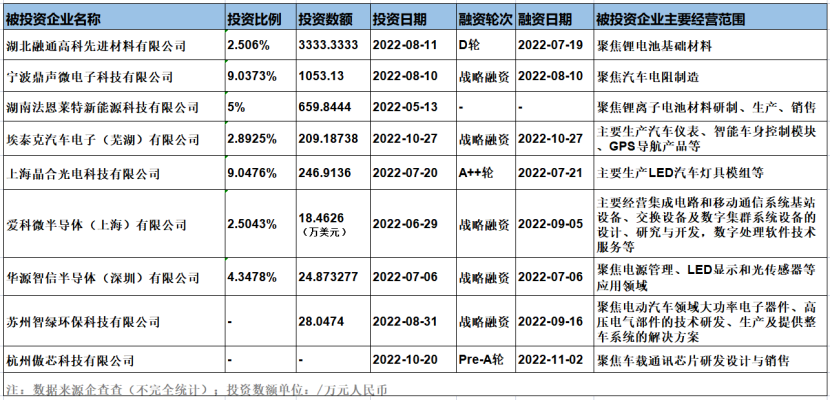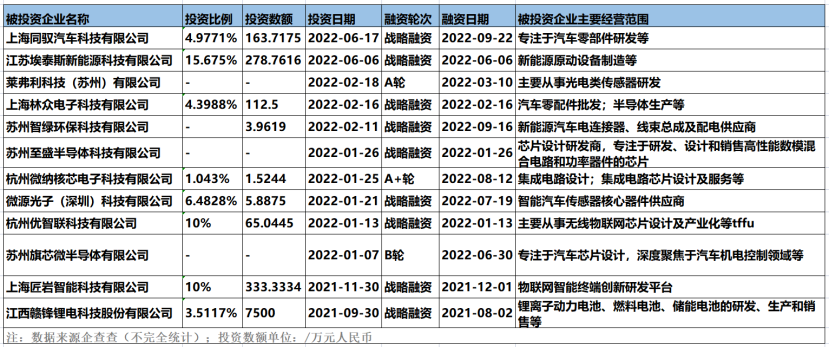Article by | Wu Yihan
Editor | Wu Xianzhi
Xiaomi recently invested exclusively in a car chip company, potentially embarking on a self-developed car chip path, which once again denied rumors that their car-making project had been halted. Now, the focus of attention is whether Xiaomi will be able to achieve mass production and delivery of cars in 2024.
While some people see a bright future for Xiaomi’s cars, others are not as optimistic, but their actions in the car-related industry have never ceased.
Investment before car-making
In March 2021, Xiaomi’s car-making project had yet to take shape, but they had already begun investing in car-related companies by investing in multiple car chip companies. In September 2021, Xiaomi invested in an autonomous driving computing chip company called Black Sesame Technologies, marking their first investment in the core chip segment of the car industry. At the same time, Xiaomi also participated in the financing of Yuntu Semiconductor and added to its hundreds of millions of dollars in A+ round financing in July 2022.
According to QCC, on October 20, 2022, Beijing Xiaomi Intelligent Manufacturing Equity Investment Partnership Enterprise (limited partnership) invested millions of yuan exclusively in the Pre-A round financing of Hangzhou Aoxin Technologies. News reports claim that this investment is aimed at the development of in-vehicle network (CAN/Ethernet PHY) series chips.
Beijing Xiaomi Intelligent Manufacturing Equity Investment Partnership Enterprise (hereinafter referred to as Xiaomi Intelligent Manufacturing) was established in September 2021 as a wholly-owned company by Xiaomi, mainly engaged in equity investment, venture capital and other businesses. Since May 2022, this company has invested in nine car-related enterprises in just six months. Excluding the investment in Aoxin Technologies, Xiaomi Intelligent Manufacturing’s total investment amount has already exceeded RMB 56 million.
Xiaomi’s automotive dream seems to be copying its own ecosystem by creating a Xiaomi automotive ecosystem. In fact, before the establishment of Xiaomi Smart Factory, Xiaomi had already invested in upstream and downstream supply chain companies in the automotive industry with the goal of building a technology and industrial pattern centered on autonomous driving. For example, Xiaomi Group’s Hubei Xiaomi Changjiang Industry Fund Partnership Enterprise (Limited Partnership) has invested in automotive-related companies since Xiaomi announced its car-making plans (incomplete statistics):

In addition, Xiaomi has also invested in automotive-related companies through its wholly-owned subsidiary, Hainan Jimu Entrepreneurship Investment Co., Ltd.

As a technology company whose main business is cellphones, why did Xiaomi choose to enter the car-making industry? Lei Jun has previously stated that in order to become a great company, one must follow the trend, and at present, the trend is in intelligent electric vehicles, which has become a fusion of the automotive industry and consumer electronics. If you don’t join in, you’ll fall behind. Thus, Xiaomi’s foray into the automotive industry is a choice forced by the circumstances.
Although Xiaomi’s entry into the automotive industry is a “choice forced by the circumstances,” Lei Jun has invested a lot of thought and effort in this field, whether in terms of investment or marketing.On October 20, Lei Jun posted on social media that electric cars are consumer electronics products that are centered around intelligence, software, and user experience. The essence of the automotive industry will shift from mechanics to consumer electronics, with market share highly concentrated among top manufacturers. Therefore, Lei Jun believes that when the electric car industry matures, the world’s top five brands will occupy more than 80% of the market share. The only way for Xiaomi’s car business to succeed is to enter the top five in the industry, with an annual shipment volume exceeding 10 million vehicles.
Industry competition is so fierce that for a newly-entered company, the goal of becoming one of the top five in the industry with an annual shipment volume of over 10 million vehicles is extremely difficult. It is unknown whether Lei Jun is too optimistic or confident.
Xiaomi’s car-making business will require a huge amount of initial investment to achieve such a daunting task, and burning money is inevitable, as can be seen from the investment list above. Xiaomi announced an initial investment of 10 billion yuan when it announced its car-making plans. They will invest 10 billion US dollars over the next 10 years, while Xiaomi Group announced a cash balance of 108 billion yuan at the end of 2020. With the investment required for Xiaomi’s car-making business, it would be difficult for them to halt the project.On August 28th, this year, Lei Jun posted a message on social media about the news of Xiaomi’s self-driving test car and included a photo of himself at the scene. In fact, Lei Jun often shares his thoughts on car manufacturing and the progress of Xiaomi’s car manufacturing on social media. It is reported that Xiaomi’s first engineering sample car officially went offline on September 28th.
When it comes to marketing, Lei Jun can be said to have hands-on experience.
Lack of car manufacturing qualification
In November 2021, Xiaomi’s automotive headquarters, R&D headquarters, and sales headquarters will be located in Yizhuang. According to the plan, Xiaomi’s car will build a vehicle factory with a capacity of 300,000 vehicles in two phases. The first phase of the factory started construction in April of this year, and is expected to be completed in June 2023. Xiaomi invested 3.3 billion yuan in R&D costs for the first phase and is expected to enter the first echelon of the industry in 2024.
However, in addition to the configuration and model of the car itself, the outside world is still very concerned about its pricing. Lei Jun once initiated a Xiaomi car pricing vote. In the vote with 17,000 participants, the most votes were for a price below 100,000 yuan, followed by 100,000-150,000 yuan, and the fewest votes were for a price above 300,000 yuan. As we all know, Xiaomi phones were born with cost performance, will Xiaomi cars also consider public opinion surveys and consider cost performance issues?
However, at present, Xiaomi’s car layouts still lack car manufacturing qualifications. In the next step, Xiaomi may need to solve this problem.
It can be seen that Xiaomi’s automotive blueprint is ambitious. Whether it can be recognized by the market and consumers in reality, remains to be seen.
This article is a translation by ChatGPT of a Chinese report from 42HOW. If you have any questions about it, please email bd@42how.com.
